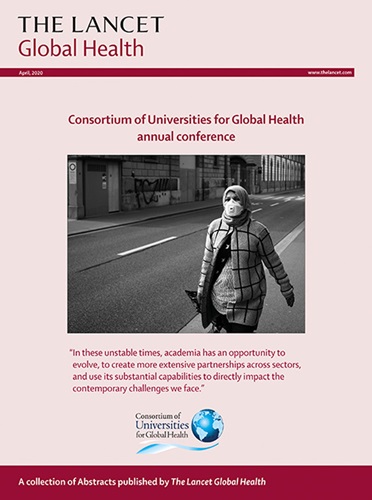Switching antibiotic therapy from injectable to oral to optimise the duration of inpatient care for young infants presenting with moderate-mortality-risk signs of possible serious bacterial infection: an open-label, multicountry, randomised controlled trial.
IF 19.9
1区 医学
Q1 PUBLIC, ENVIRONMENTAL & OCCUPATIONAL HEALTH
引用次数: 0
Abstract
BACKGROUND In low-resource settings, challenges in hospitalisation stay for sick young infants younger than 2 months persist. Early discharge of young infants with moderate-mortality-risk possible serious bacterial infection (PSBI) signs might provide a safe and effective alternative. We compared the clinical outcomes of switching parenteral antibiotics to oral antibiotics along with hospital discharge after 48 h of admission with those who continued hospitalisation for 7 days. METHODS An open-label, multicountry, multicentre, individually randomised controlled trial was done in Bangladesh, Ethiopia, India, Nigeria, Pakistan, and Tanzania. Young infants aged 1-59 days presenting with moderate-mortality-risk PSBI signs were screened and hospitalised for inpatient care with injectable ampicillin and gentamicin. After 48 h of admission, young infants without any PSBI sign, and negative C-reactive protein, were randomly assigned to either the intervention (outpatient) group (discontinuation of injectable antibiotics and hospital discharge after switching to oral amoxicillin twice daily for 5 more days) or the control group (continued inpatient care). Treatment received throughout was documented on days 4 and 8 of initiation, and outcomes on days 4, 8, and 15. The primary outcome of poor clinical outcome was a hierarchical composite indicator that included death (any time after randomisation up to day 15 of initiation of therapy), presence of any sign of critical illness (no movement at all, unable to feed at all, or convulsions), or any sign suggestive of another serious infection, such as meningitis, bone or joint infection (on day 4 or day 8 of initiation of therapy), and presence of any sign of clinical severe infection (CSI) (on day 8 of initiation of therapy). The non-inferiority margin was set at 2%. We did a per-protocol analysis to compare the proportions of primary outcome between the two groups and reported risk differences (RDs) with 95% CI. The study is registered with the ISRCTN registry (ISRCTN16872570). FINDINGS Between June 24, 2021, and Aug 7, 2024, of 6549 young infants with moderate-mortality-risk PSBI signs who were reassessed after 48 h of admission, 5253 (80·3%) were randomly assigned to the outpatient group (n=2635) or the inpatient care group (n=2618). Treatment adherence was 96·7% (2549 of 2635) in the oral amoxicillin group and 95·7% (2506 of 2618) in the inpatient care group (with at least 80% of the antibiotic dosage received). In the per-protocol analysis, the rate of poor clinical outcome was 4·0% (105 of 2616) in the outpatient group and 3·5% (90 of 2603) in the inpatient care group (RD 0·0056 [95% CI -0·0047 to 0·0158]). The most common reason for poor clinical outcome was any sign of CSI at day 8 (3·4% in the outpatient group and 2·6% in the inpatient care group). Six (0·2%) young infants died in the outpatient group and eight (0·3%) in the inpatient care group. Besides deaths, two young infants developed serious adverse events, and both were in the inpatient group. INTERPRETATION Discontinuation of the injectable antibiotics and switching to oral antibiotics with early hospital discharge in young infants with moderate-mortality-risk PSBI signs was effective and safe in diverse low-income and middle-income countries in Africa and Asia. This could optimise health systems and family resources, as well as decreasing the risk of hospital-acquired infections compared with the currently recommended 7-10 days of inpatient care. FUNDING Gates Foundation.将抗生素治疗从注射改为口服,以优化具有可能严重细菌感染的中等死亡风险体征的幼儿的住院护理时间:一项开放标签、多国随机对照试验。
背景:在资源匮乏的环境中,小于2个月的患病婴儿住院的挑战依然存在。早期出院具有中等死亡风险的可能严重细菌感染(PSBI)体征的婴儿可能是一种安全有效的替代方法。我们比较了在入院48小时后将肠外抗生素改为口服抗生素并出院的患者与继续住院7天的患者的临床结果。方法在孟加拉国、埃塞俄比亚、印度、尼日利亚、巴基斯坦和坦桑尼亚进行一项开放标签、多国、多中心、单独随机对照试验。年龄在1-59天、出现中等死亡风险PSBI体征的婴儿被筛选,并接受注射氨苄西林和庆大霉素的住院治疗。入院48小时后,无任何PSBI体征和c反应蛋白阴性的婴儿被随机分配到干预(门诊)组(停止注射抗生素并在改用口服阿莫西林两次后出院,持续5天以上)或对照组(继续住院治疗)。在开始治疗的第4天和第8天记录整个治疗过程,并在第4、8和15天记录结果。不良临床结果的主要结局是一个分层复合指标,包括死亡(随机化后的任何时间,直到开始治疗的第15天),出现任何危重疾病的迹象(完全没有运动,根本无法进食,或抽搐),或任何提示其他严重感染的迹象,如脑膜炎,骨或关节感染(开始治疗的第4天或第8天)。并且存在任何临床严重感染(CSI)的迹象(在开始治疗的第8天)。非劣效性裕度设定为2%。我们进行了一项方案分析,比较两组间主要结局的比例和报告的风险差异(RDs) (95% CI)。该研究已在ISRCTN注册中心注册(ISRCTN16872570)。研究结果:在2021年6月24日至2024年8月7日期间,6549名具有中等死亡风险PSBI体征的婴儿在入院48小时后重新评估,其中5253名(80.3%)被随机分配到门诊组(n=2635)或住院护理组(n=2618)。口服阿莫西林组的治疗依从性为96.7%(2635例中有2549例),住院护理组的治疗依从性为95.7%(2618例中有2506例)(至少接受了80%的抗生素剂量)。在按方案分析中,门诊组临床预后不良率为4.0%(2616例中有105例),住院组为3.5%(2603例中有90例)(RD为0.0056 [95% CI - 0.0047 ~ 0.0158])。临床结果不佳的最常见原因是在第8天出现任何CSI迹象(门诊组为3.4%,住院组为2.6%)。门诊组死亡6例(0.2%),住院组死亡8例(0.3%)。除死亡外,两名婴儿出现严重不良事件,均为住院组。在非洲和亚洲的多个低收入和中等收入国家,对有中等死亡风险PSBI体征的幼儿在早期出院时停用注射抗生素并改用口服抗生素是有效和安全的。与目前推荐的7-10天住院治疗相比,这可以优化卫生系统和家庭资源,并降低医院获得性感染的风险。FUNDINGGates基础。
本文章由计算机程序翻译,如有差异,请以英文原文为准。
求助全文
约1分钟内获得全文
求助全文
来源期刊

Lancet Global Health
PUBLIC, ENVIRONMENTAL & OCCUPATIONAL HEALTH-
CiteScore
44.10
自引率
1.20%
发文量
763
审稿时长
10 weeks
期刊介绍:
The Lancet Global Health is an online publication that releases monthly open access (subscription-free) issues.Each issue includes original research, commentary, and correspondence.In addition to this, the publication also provides regular blog posts.
The main focus of The Lancet Global Health is on disadvantaged populations, which can include both entire economic regions and marginalized groups within prosperous nations.The publication prefers to cover topics related to reproductive, maternal, neonatal, child, and adolescent health; infectious diseases (including neglected tropical diseases); non-communicable diseases; mental health; the global health workforce; health systems; surgery; and health policy.
 求助内容:
求助内容: 应助结果提醒方式:
应助结果提醒方式:


